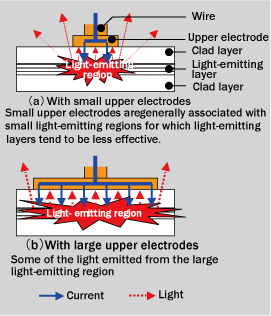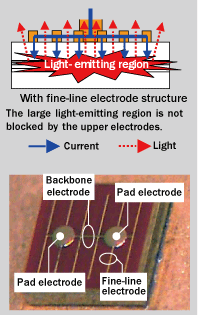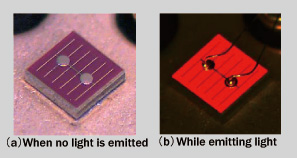2010 The former Hitachi Cable News Release
Information (including product prices, product specifications, details of services, launch dates, inquiry information, and URLs) contained in this news release is current as of the date of the press release but is subject to change without notice. Please note that details may differ from those effective on the search date.
Hitachi Cable develops high-power 55-lumen red LED chips
Hitachi Cable, Ltd. has announced the development of a high-power red LED chip*1 offering a maximum luminous flux of 55 lumens*2,*3. This luminous flux was enabled by increasing the size of the LED chip and use of a fine line electrode structure.
LEDs are semiconductor solid-state components that convert electricity directly into light. With their capacity to emit light of a specific color without color filters and at low operating voltages, LEDs are used as indicator lights in a wide range of equipment, appliances, and devices. Recent progress in luminous efficiency and the widespread commercial manufacture of blue and green LEDs has rapidly expanded the use of LEDs in full color display and illumination applications, including traffic lights, automobile rear signal lamps, and large outdoor display panels.
Hitachi Cable manufactures supplies aluminum gallium arsenide (AlGaAs) epitaxial wafers and aluminum gallium indium phosphorus (AlGaInP) epitaxial wafers, both of which are compound semiconductor wafers for red LEDs. In response to demand for LEDs of higher luminous efficiency, the company has also developed a high-brightness red LED chips (hereafter referred to as an "MR-LED chips") that form a metal reflector (MR) under the light emitting layer. This product is currently being supplied to LED package manufacturers and other customers.
Through its LED business, Hitachi Cable has recognized the growing demand for higher output LED chips. The company has incorporated fine electrode structures and enlarged chip dimensions to develop high-power red LED chips offering outputs as high as 55 lumens.
One of the methods of improving per-chip light output is to increase the chip dimensions. However, larger chips increase the difficulty in distributing a uniform current across the entire light emitting layer. On the other hand, if large electrodes are positioned in the upper layer of the chip for a more uniform current dispersion, light from the light emitting layer will be blocked, reducing the light extraction efficiency (see Fig. 1, "Problems caused by enlarged chip size").
To resolve these problems in developing a new LED chip, instead of using larger electrodes, Hitachi Cable has utilized two pad electrodes for receiving power, a backbone electrode connecting the two electrodes, and multiple fine line electrodes that extend from the backbone electrode on the upper chip layer (see Fig. 2, "Structure of new high-power red LED").
By employing fine line electrodes, Hitachi Cable has succeeded in achieving uniform dispersion of current across the entire chip surface without blocking light from the light emitting layer, thus attaining a maximum luminous flux of 55 lumens in a large LED chip measuring 1 mm by 1 mm-equivalent to the combined output of 21 MR-LED chips (0.33 mm × 0.33 mm).*4 With its higher output, the new LED chip is expected to find applications not only in display applications, but also as a light source for devices such as projectors.
Hitachi Cable will continue to pursue active development of higher-power LED chips while expanding its lineup of high-power LED chips, including yellow and infrared LED chips.
| *1 | LED stands for Light Emitting Diode. |
| *2 | Lumen (lm) is a unit for light intensity that accounts for the human eye's sensitivity to visible light. |
| *3 | Optical output at a current of 500 mA |
| *4 | Compared to our MR-LED chip (0.33 × 0.33 mm, at 20 mA, 2.6 lm) |
Fig.1 Problems caused by enlarged chip size |
Fig.2 Structure of new high-power red LED |
|
Fig. 3 External views of high-power red LED


